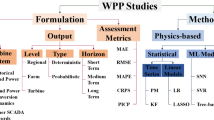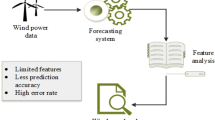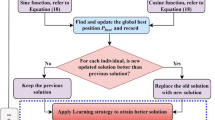Abstract
This paper proposes an optimal scheduling/allocation of energy and spinning reserves for a wind-thermal power system. There is a considerable need for the renewable energy resources in the modern power system; therefore, in this paper, wind energy generators are used. Here, two different market clearing models are proposed. One model includes reserve offers from the conventional thermal generators, and the other includes reserve offers from both thermal generators, and demand/consumers. The stochastic behavior of wind speed and wind power generation is represented by the Weibull probability density function. The objective function considered in this paper includes cost of energy provided by conventional thermal and wind generators, cost of reserves provided by conventional thermal generators and load demands. It also includes costs due to under-estimation and over-estimation of available wind power generation. Clustered adaptive teaching learning based optimization algorithm is used to solve the proposed optimal scheduling problem for both conventional and wind-thermal power systems considering the provision for spinning reserves. To show the effectiveness and feasibility of the proposed frame work, various case studies are presented for two different test systems.


Similar content being viewed by others
Abbreviations
- \(a_{i}\), \(b_{i}\), \(c_{i}\) :
-
Cost coefficients of thermal generator i
- \(a_{k}^{'}\), \(b_{k}^{'}\), \(c_{k}^{'}\) :
-
Cost coefficients of demand-side reserve (DR) offers for kth load/demand
- c, k :
-
Scale factor and shape factor of Weibull distribution at a given location
- \(C_{\mathrm{G}i}\) :
-
Fuel cost function of thermal generator i
- \(C_{\mathrm{w}j}\) :
-
Direct cost function of wind generator j
- \(C_k\) :
-
Cost function for demand response (DR) offers of load demand k
- \(C_{\mathrm{SR}i}\) :
-
Spinning reserve (SR) cost function of thermal generator i
- \(C_{\mathrm{p,w}j}\) :
-
Penalty cost function for not using all available power from jth wind power generator
- \(C_{\mathrm{r,w}j}\) :
-
Reserve cost function relating to uncertainty of wind power. This is effectively a penalty associated with over-estimation of the available wind power
- \(d_{j}\) :
-
Direct cost coefficient of jth wind generator
- \(e_i\), \(f_i\) :
-
Cost coefficients of the thermal generator with valve-point loading effects
- \(f_p(p)\) :
-
Wind energy generator (WEG)/wind power probability density function (PDF)
- n :
-
Number of buses in the system
- \(N_\mathrm{G}\) :
-
Number of conventional thermal generators
- \(N_\mathrm{L}\) :
-
Number of loads/demands
- \(N_\mathrm{W}\) :
-
Number of wind generators/farms
- p :
-
WEG power output in MWs
- \(P_\mathrm{D}\) :
-
Total system demand in MWs
- \(P_{\mathrm{G}i}\) :
-
Scheduled power from ith conventional thermal generator in MWs
- \(P_{\mathrm{G}i}^{0}\) :
-
Power output of ith conventional thermal generator at previous hour in MWs
- \(P_{\mathrm{G}i}^\mathrm{min}\), \(P_{\mathrm{G}i}^\mathrm{max}\) :
-
Minimum and maximum power limits of ith generator in MWs
- \(P_{\mathrm{r}j}\) :
-
Rated wind power from jth wind generator
- \(P_{\mathrm{SR}i}\) :
-
Amount of spinning reserve (SR) provided by ith conventional thermal generator in MWs
- \(P_{\mathrm{SR}i}^\mathrm{max}\) :
-
Maximum reserve capacity of ith conventional thermal generator in MWs
- \(P_{\mathrm{shd,}k}\) :
-
Amount of demand response (DR) provided by kth demand in MWs
- \(P_{\mathrm{wf,}j}\) :
-
Forecasted wind power from jth wind generator in MWs
- \(P_{\mathrm{w}j}\) :
-
Scheduled wind power from jth wind generator in MWs
- \(P_{\mathrm{w}j,\mathrm{av}}\) :
-
Available wind power from the jth wind power generator. This is a random variable, with a range of \(0 \le P_{\mathrm{w}j,\mathrm{av}} \le P_{\mathrm{r}j}\)
- \(Q_{\mathrm{G}i}\) :
-
Reactive power output of ith generator
- \(R_{\mathrm{G}i}^\mathrm{down}\), \(R_{\mathrm{G}i}^\mathrm{up}\) :
-
Ramp down and ramp up limits of conventional thermal generators (MW/h)
- \(T_\mathrm{F}\) :
-
Teaching factor
- \(r_{i}\) :
-
Random number in the range [0, 1]
- \(V_{i}\), \(V_{j}\) :
-
Voltage magnitudes at bus i and bus j
- v :
-
Wind speed (m/s)
- \(v_{r}\), \(v_{i}\), \(v_{o}\) :
-
Rated, cut-in and cut-out wind speeds (m/s)
- \(x_{i}\), \(y_{i}\) :
-
Spinning reserve (SR) cost coefficients of thermal generator i
- \(\delta _{i}\), \(\delta _{j}\) :
-
Voltage angles at bus i and bus j
References
Ela E, Kirby B, Lannoye E, Milligan M, Flynn D, Zavadil B, Malley MO Evolution of operating reserve determination in wind power integration studies. Available [online] :www.nrel.gov/docs/fy11osti/49100
Liu K, Zhong J (2010) Generation dispatch considering wind energy and system reliability. In: IEEE power and energy society general meeting, pp 1–7
Song Z, Goel L, Wang P (2005) Optimal spinning reserve allocation in deregulated power systems. IEE Gen Trans Distriub 152(4):483–488
Billinton R, Karki R (1999) Capacity reserve assessment using system well-being analysis. IEEE Trans Power Syst 14:433–438
PJM (2014) PJM Manual 11: energy and ancillary services market operations. Available [online]: http://www.pjm.com/~/media/documents/manuals/m11.ashx
New York Independent System Operator: Ancillary Services Manual, Revision 2.0. Available [online]: http://www.nyiso.com/services/documents/manuals/index.html
Wang P, Zareipour H, Rosehart WD (2011) Characteristics of the prices of operating reserves and regulation services in competitive electricity markets. Energy Policy 39:3210–3221
California ISO (2002) Ancilliary services overview. Available [online]: http://www.caiso.com/clientserv/settlements/SettlementsGuide/index.html
Walawalkar R, Fernands S, Thakur N, Chevva KR (2010) Evolution and current status of demand response (DR) in electricity markets: Insights from PJM and NYISO. Energy 35:1553–1560
Parvania M, Fotuhi-Firuzabad M (2010) Demand response scheduling by stochastic SCUC. IEEE Trans Smart Grid 1(1):89–98
Parvania M, Fotuhi-Firuzabad M (2012) Integrating load reduction into wholesale energy market with application to wind power integration. IEEE Syst J 6(1):35–45
Wang J, Redondo NE, Galiana FD (2003) Demand side reserve offers in joint energy/reserve electricity markets. IEEE Trans Power Syst 18(4):1300–1306
Karangelos E, Bouffard F (2012) Towards full integration of demand-side resources in joint forward energy/reserve electricity markets. IEEE Trans Power Syst 27(1):280–289
Wong S, Fuller JD (2007) Pricing energy and reserves using stochastic optimization in an alternative electricity market. IEEE Trans Power Syst 22(2):631–638
Lakshmi K, Vasantharathna S (2014) Gencos wind-thermal scheduling problem using Artificial immune system algorithm. Int J Electron Power Energy Syst 54:112–122
Niknam T, Abarghooee RA, Roosta A (2012) Reserve constrained dynamic economic dispatch: a new fast self-adaptive modified firely algorithm. IEEE Syst J 6(4):635–646
Bouchekara HREH, Abido MA, Boucherma M (2014) Optimal power flow using teaching–learning-based optimization technique. Electr Power Syst Res 114:49–59
Ghasemi M, Ghavidel S, Gitizadeh M, Akbari E (2015) An improved teaching–learning-based optimization algorithm using Levy mutation strategy for non-smooth optimal power flow. Int J Electr Power Energy Syst 65:375–384
Chen C, Wang F, Zhou B, Chan KW, Cao Y, Tan Y (2015) An interval optimization based day-ahead scheduling scheme for renewable energy management in smart distribution systems. Energy Convers Manag 106:584–596
Khare V, Nema S, Baredar P (2016) Solar-wind hybrid renewable energy system: a review. Renew Sustain Energy Rev 58:23–33
Izadbakhsh M, Gandomkar M, Rezvani A, Ahmadi A (2015) Short-term resource scheduling of a renewable energy based micro grid. Renew Energy 75:598–606
Najibi F, Niknam T (2015) Stochastic scheduling of renewable micro-grids considering photovoltaic source uncertainties. Energy Convers Manag 98:484–499
Reddy SS, Momoh JA (2015) Realistic and transparent optimum scheduling strategy for hybrid power system. IEEE Trans Smart Grid 6(6):3114–3125
Sahin C, Shahidehpour M, Erkmen I (2013) Allocation of hourly reserve versus demand response for security-constrained scheduling of stochastic wind energy. IEEE Trans Sustain Energy 4(1):219–228
Jadhav HT, Chawla D, Roy R (2012) Modified teaching learning based algorithm for economic load dispatch incorporating wind power. In: 11th International conference on environment and electrical engineering (EEEIC), pp 397–402
Ortega-Vazquez MA, Kirschen DS (2009) Estimating the spinning reserve requirements in systems with significant wind power generation penetration. IEEE Trans Power Syst 24(1):114–124
Ortega-Vazquez MA, Kirschen DS (2009) Should the spinning reserve procurement in systems with wind power generation be deterministic or probabilistic? In: International conference on sustainable power generation and supply, pp 1–9
Satapathy SC, Naik A (2011) Data clustering based on teaching learning based optimization. In: Proceedings of 2nd international conference on swarm, evolutionary, and memetic computing, Vol Part II, pp 148–156
Hejazi HA, Mohabati HR, Hosseinian SH, Abedi M (2011) Differential evolution algorithm for security-constrained energy and reserve optimization considering credible contingencies. IEEE Trans Power Syst 26:1145–1155
Hemamalini S, Simon SP (2008) Emission constrained economic dispatch with valve-point effect using particle swarm optimization. In: IEEE region 10 conference (TENCON), pp 1–6
IEA Wind Energy (2009) Annual report 2008 international energy agency
[Online]. Available: http://www.uwig.org/windinmarketstableOct2011
Hetzer J, Yu DC, Bhattarai K (2008) An economic dispatch model incorporating wind power. IEEE Trans Energy Conver 23:603–611
Reddy SS, Bijwe PR, Abhyankar AR (2015) Optimal posturing in day-ahead market clearing for uncertainties considering anticipated real-time adjustment costs. IEEE Syst J 9(1):177–190
Reddy SS, Bijwe PR, Abhyankar AR (2015) Joint energy and spinning reserve market clearing incorporating wind power and load forecast uncertainties. IEEE Syst J 9(1):152–164
Hazra J, Sinha AK (2007) Congestion management using multi-objective particle swarm optimization. IEEE Trans Power Syst 22(4):1726–1734
PJM Manual: Energy and Ancillary Services Market Operations [Online]. Available: http://www.pjm.com
Motamedi A, Firuzabad MF, Zareipour H (2008) Optimum simultaneous clearing of energy and spinning reserve markets using cost/benefit analysis. In: IEEE power and energy society general meeting, pp 1–7
Fu Y, Shahidehpour M, Li Z (2005) Security-constrained unit commitment with AC constraints. IEEE Trans Power Syst 20(3):1538–1550
Surender Reddy S, Panigrahi BK, Kundu R, Mukherjee R, Debchoudhury S (2013) Energy and spinning reserve scheduling for a wind-thermal power system using CMA-ES with mean learning technique. Electr Power Energy Syst 53:113–122
Arroyo JM, Galiana FD (2005) Energy and reserve pricing in security and network -constrained electricity markets. IEEE Trans Power Syst 20(2):634–643
Rao R, Savsani VJ, Vakharia D (2011) Teachinglearning-based optimization: a novel method for constrained mechanical design optimization problems. IEEE Trans Comput Aided Des 43(3):303–315
Crepinek M, Liu SH, Mernik L (2012) A note on teachinglearning-based optimization algorithm. Inf Sci 212:79–93
Rao R, Savsani VJ, Vakharia D (2012) Teachinglearning-based optimization: an optimization method for continuous non-linear large scale problems. Inf Sci 183(1):1–15
Surender Reddy S, Abhyankar AR, Bijwe PR (2012) Market clearing for a wind-thermal power system incorporating wind generation and load forecast uncertainties. In: IEEE PES general meeting, pp 1–8
Justus CG, Hargraves WR, Mikhail A, Graber D (1978) Methods for estimating wind speed frequency distributions. J Appl Meteorol 17:350–353
Patel MR (1999) Wind and solar power systems. CRC Press, Raton, FL
Masters GM (2004) Renewable and efficient electric power systems. Wiley, New Jersey
Bhuiyan FA, Yazdani A (2010) Reliability assessment of a wind-power system with integrated energy storage. IET Renew Power Gen 4:211–220
Liu X, Xu W (2010) Minimum emission dispatch constrained by stochastic wind power availability and cost. IEEE Trans Power Syst 25:1705–1713
Roy S (2002) Market constrained optimal planning for wind energy conversion systems over multiple installation sites. IEEE Trans Energy Conver 17:124–129
Liu X, Xu W (2010) Economic load dispatch constrained by wind power availability: a here-and-now approach. IEEE Trans Sustain Energy 1:2–9
[Online]. Available: http://www.ee.washington.edu/research/pstca
Author information
Authors and Affiliations
Corresponding author
Rights and permissions
About this article
Cite this article
Reddy, S.S. Optimal scheduling of wind-thermal power system using clustered adaptive teaching learning based optimization. Electr Eng 99, 535–550 (2017). https://doi.org/10.1007/s00202-016-0382-5
Received:
Accepted:
Published:
Issue Date:
DOI: https://doi.org/10.1007/s00202-016-0382-5




